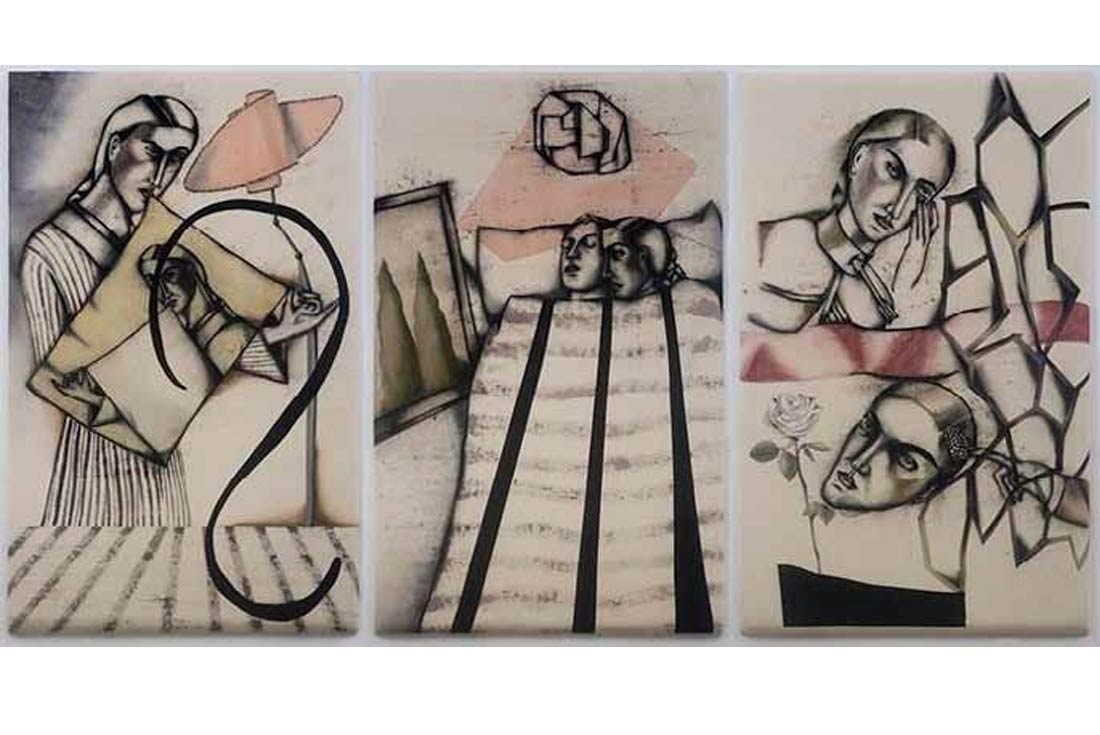
Flip | Room with a view | Honeycomb | Watercolour and charcoal on unbleached cotton fabric stretched on padded board 163 x 102 cm | 2018

Flip | Room with a view | Honeycomb | Watercolour and charcoal on unbleached cotton fabric stretched on padded board 163 x 102 cm | 2018
Presenting artists and their work straight from Art Basel at the Chemould Prescott Booth.
Anju Dodiya
Mattresses belong to the domestic terrain and here, I continue to explore their surface as a base to paint images of the home, dream and body. Desires and aspirations are just a flip second away from the real. The process of staining and marking with watercolour and charcoal on the unbleached cotton, which resists, is playful. The geometric shapes and lines refer to the modernist minimal art of the 70s, while the elements of the lamp (after Carlo Mollino) and the landscape (after the Italian primitives) betray my attitude of devouring images from diverse sources and spilling them onto my work.
These drawings with the humility of the mundane, exist between the mysterious moment when all is familiar and yet nothing is – in the artist’s studio, in the bedroom or in love.
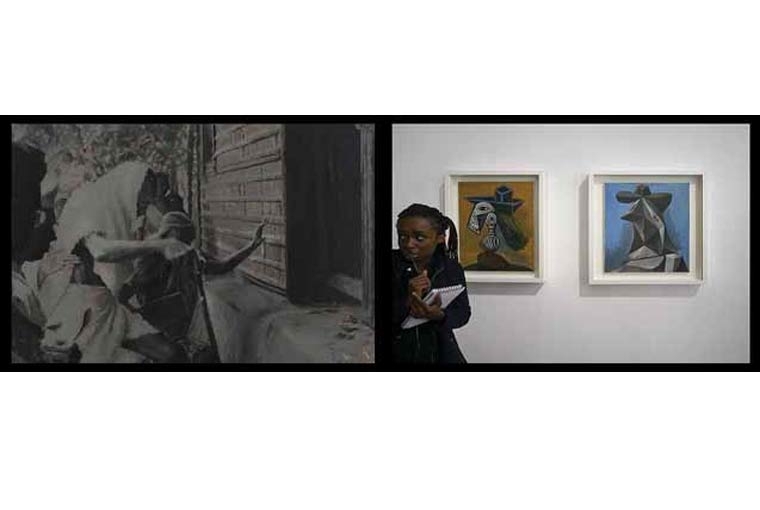
Atul Dodiya
Noakhali, November 1946 | Left panel: Oil on canvas | Right panel: Archival digital print on hahnemuehle bamboo paper, installed size: 51 x 152 cm
Atul Dodiya
The works Painted Photographs / Paintings Photographed, or Mahatma and Masters shows my interest in the first half of the 20th century in India and Europe. I have juxtaposed two totally different movements in history, arranging them side by side. In the first half of 20th century Europe, a huge dramatic shift took place, particularly in France, with artists like Henri Matisse, Pablo Picasso, Marcel Duchamp, who changed the whole notion of art. During this period, India was fighting for freedom, which resulted in the Independence from British rule and ended with Gandhi’s assassination. Photography has a key role to play in this body of work. Gandhi’s life in the context of India’s freedom is available in written words and in photographs. Here, we have those images painted in oil on canvas. Conversely, the original paintings and sculptures by modern Masters, which were created during that period, are what we see here in the form of photographs. I was interested in this reversal of photographs getting transformed into paintings and paintings/sculptures being seen here in the form of photographs.
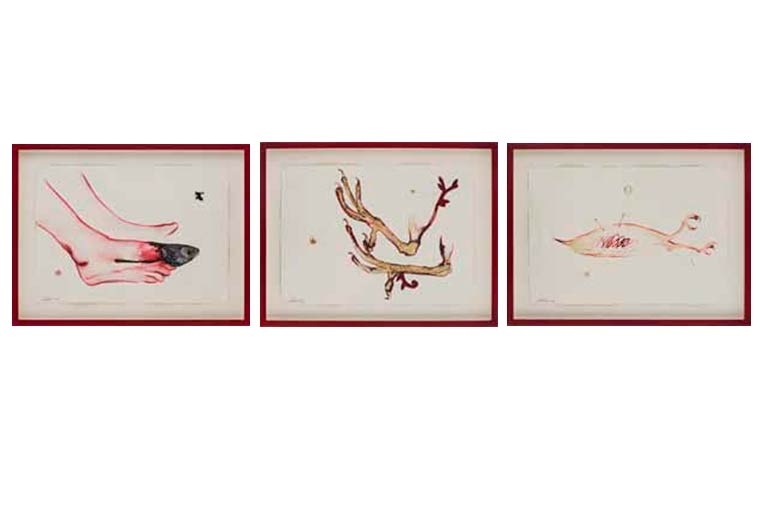
Mithu Sen
Museum piece #4- (un)drawing | Time, handmade paper, red ink, drawing, inbetweeness | 51 x 40 x 6 cm each | 1997-2017 (ongoing)
Mithu Sen
Museum Piece #4 - (un)drawing
I, mithu sen, declare that from 01.01.18 till my next declaration in the future, all mix media drawings measuring 15 inches x 12 inches, mainly with red ink and collage on white hand made paper, will be dated randomly anytime and anywhere between 1997 to 2017. The date/provenance will not be indicative of the actual date of production. Each byproduct will be offered to interested buyers at 10% (5% 5%) lesser than the current market value at the time of the sale.
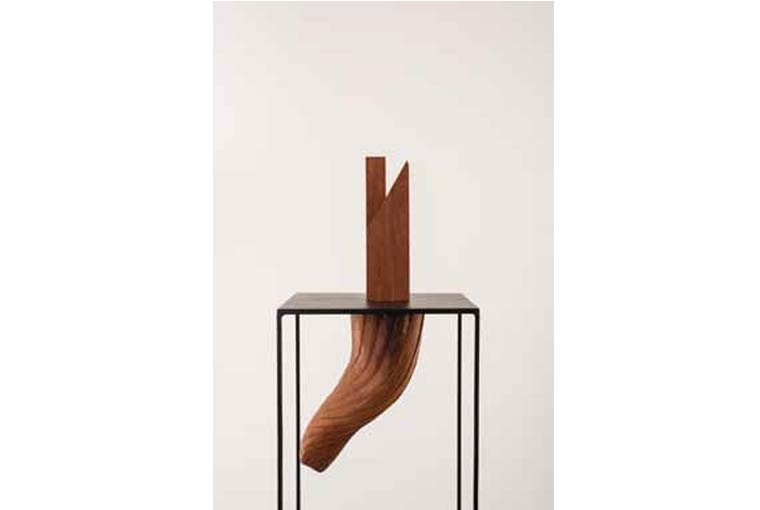
Bhuvanesh Gowda
Antarmukhi II | Carving on wood charred, powder coated steel 140 x 43 x 36 cm | 2016
Bhuvanesh Gowda
In the Antarmukhi I and II, Antar - meaning inside and Mukh - meaning the mouth, or more appropriately here, the entry point; Bhuvanesh Gowda has created a statement about the starting point of looking inwards and within. In a unique pedestal like structure, these carved salvaged wood sculptures breathe in the movement suspended in time, and the concept of introspection and retrospection is wounded into the ethos of Gowda’s artistic practice.
Ritesh Meshram
Ritesh Meshram has harked back to the simpler ethos of being homeward bound. With heavy rusted metal, attractive to Meshram due to its material nature and the sound, he has created mirror images of an eye, a hammer and a hut. He feels that they evoke the feeling of being easily held in one’s palm and setting out on a walk down the street, but also, kept together, they are engaged in deep conversation and discord which is Meshram’s reflection of contemporary society ingrained with contentious social and political issues.
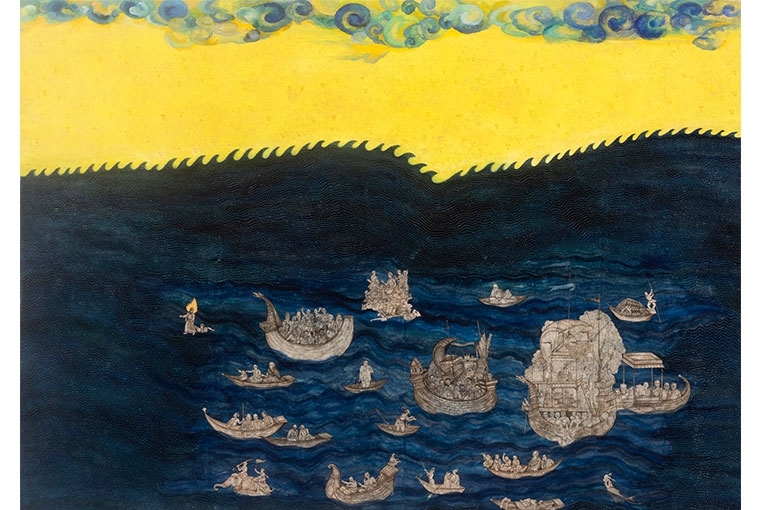
Varunika Saraf
“Speak, your life is still your own†| Watercolour and glass beads on paper pasted on cotton textile | 132 x 193 cm | 2018
Varunika Saraf
The title of this work, Speak, your life is still your own, is a line borrowed from the English translation of Faiz Ahmed Faiz’s poem Bol ke lab azaad hai teray. This poem is particularly relevant in today’s context as it urges us to speak out against injustice before it is too late. The rise of right-wing populism in India has resulted in increased violence against the marginalised, particularly the Muslims, Dalits and other ethnic minorities. Social justice and fundamental rights guaranteed by the Indian Constitution are increasingly challenged. In order to enforce the Hindutva worldview on the country, the right-wing in India attempts to rewrite history. Every example that represents a progressive and syncretic tradition is perceived as a threat.
We need to dispel the collective amnesia that is gripping the society and resist all attempts made by the right to rewrite history and tamper with the social fabric of the society. This painting is a call to fight equally for our past and present, so that we may still have a future. To look at our history without the lens of nostalgia, to remember people without placing them on pedestals, to learn, question, reclaim and grow, both from their insights as well as shortcomings. As Eduardo Galeano suggests, we have to “search for the keys in the past history to explain our time”, particularly listen to the voices from our past, even if they are contradictory to reflect upon the conflict and violence that is consuming our world. This painting highlights the importance of remembering certain individuals and their vision before the right consigns them into oblivion.
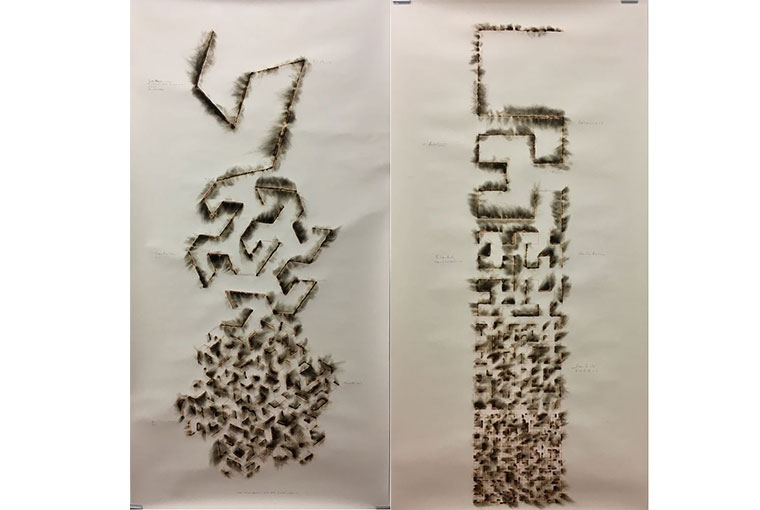
Jitish Kallat
Wind Study | Burnt adhesive, aquarelle pencil and graphite on paper | 229 x 114 cm each | 2018
Jitish Kallat
Jitish Kallat’s elemental, meditative works titled Wind Study (Hilbert Curve) and Wind Study (Gosper Curve) derive their form from clusters of Hilbert Curves and Gosper Curves, which are continuous fractal-like, space- filling curves named after mathematicians David Hilbert and Bill Gosper respectively. A single curling line that extends across various dimensions of curves forms each of these drawings. Each small fragment of the curve is overlaid, one line at a time, with an inflammable liquid and set aflame. Within moments the ignited portion of the line undergoes phase transition from liquid to semisolid to fire, to finally arise as dark fumes that record for posterity the movement of the wind at that moment in time. Functioning like exploratory instruments to eavesdrop on invisible atmospheric flows, Kallat describes these evocative drawings as “transcripts of the silent conversation between wind and fire”.
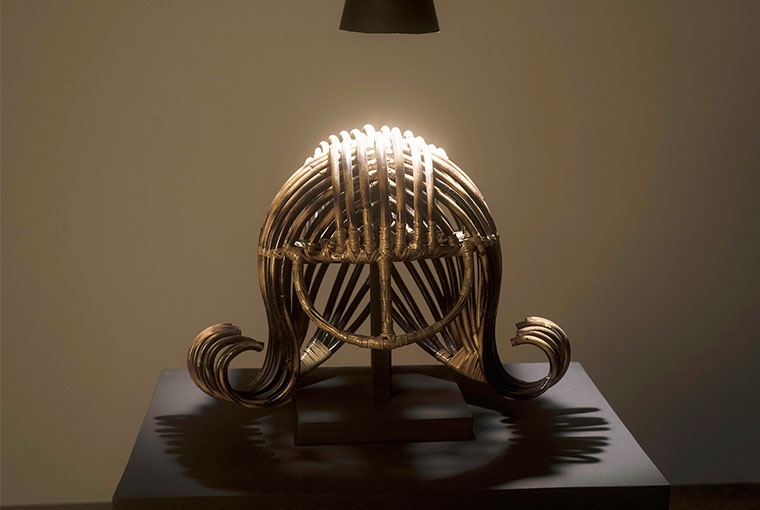
Shakuntala Kulkarni
Untitled | Cane | size variable | 2015-18
Shakuntala Kulkarni
Her decade long research inspired by the idea of protection for the female form, the Terracotta Army, and the contemporary societal set up, has led Shakuntala Kulkarni to create a multimedia exploration. She learnt the craft of cane making to make the armour she adorns while being digitally recorded through the lanes of Mumbai, and as part of her film Julus. Deconstructed into these pedestals here, these cane sculptures now carry the embedded memory of having been part of her journey as a Zen warrior traversing and reclaiming an important narrative of history.
Gigi Scaria
In a distinct turn from his commentary on urban landscapes, Scaria has commentated on the undercurrents of everyday existence of citizens, being pushed beyond their control. Perched at eye level on bricks with alphabetical indentations, with life like proportions, these bronze humanoid figurines are not more than 18 inches in height. Eager to give form to his personal interest in working with the human figure and form, the equanimity of this sculpture captures the moment between complete submission to circumstance, and perceived control over them.
Desmond Lozaro
Buckminster Fuller’s Dymaxion map, which was published in 1943 as a DIY kit in Life Magazine, constituted of eight triangles and six squares. This mental construction is based on an alternative comprehension of the world, which abandons the Mercator projection and its use of the equator as the reference line. Its aim is to minimize the distortions of conventional representations of the earth and their embedded cultural biases. Inspired by Fuller’s non- hierarchical approach to geography, in which there is no up or down, no north or south, these three-dimensional Dymaxion maps are rendered in the form of an icosahedron mobile, and Lazaro transcribes onto the icosahedron his family’s migration route in the 1950’s from Burma to the United Kingdom. Those routes have been set against the great maritime voyages of Vasco Da Gama, Ferdinand Magellan, Christopher Columbus, James Cook – explorers who followed their Arab and African predecessors, and thus instigated modern global trade.